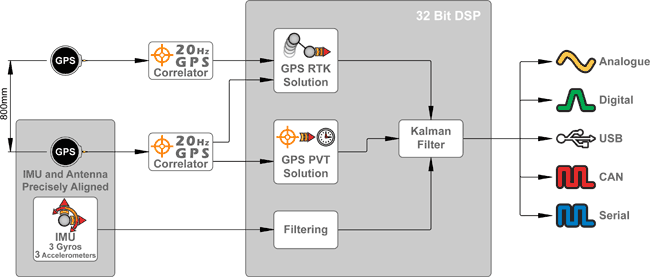SPEEDBOX INS Option
The SPEEDBOX INS option combines high precision GPS and IMU measurements from an innovative new antenna assembly into a full INS solution for incredibly accurate results. It measures heading, gradient, position, velocity, accelerations, distance and vehicle attitude (roll, pitch and yaw) all at 200Hz . The full product description can be found here.
Two versions of the SPEEDBOX INS option are available:
- Tactical grade dual antenna
- Tactical grade single antenna
The single antenna system is ideal for the vast majority of installations in automotive testing and racing, where a non-permanent quickly removable system is required. The dual antenna version is required only for very slow moving vehicles such as mining equipment or agricultural applications.
Installation instructions:
How the INS system works:
SPEEDBOX-INS System Flowchart
The Kalman filter in the SPEEDBOX INS system combines the data from the GPS, accelerometers, and gyros to give roll, pitch and yaw rates and angles, position, 3 axis acceleration and speed. The combining of this data to give a low latency output is calculated using two distinct solutions.
There is a main solution which runs behind time, the limit on the timing of this solution is how far behind current time the slowest data source runs, in this case the GPS data. The system takes the errors from the output (difference between GPS and the INS mechanisation) and estimates what probably caused those errors, eg biases on gyros or accelerometers. This solution typically runs around 100ms behind current time.
There is then a second solution which runs "on time", this solution take the last output from above and all the outputs from the accelerometers and gyros since that time to work out the most up to date solution possible. This solution is limited by the speed of the inertial sensors rather than the GPS so has a much lower latency. The latency for this is the sum of the times for:
- Reading the inertial sensor data
- Calculating the solution
- Transmitting the data or updating analogue outputs
This latency varies as the solution calculation time is not deterministic, it is typically around 10-15ms. To ensure that the published specification the output latency can always be met, the output latency is fixed at 30ms or 150ms, the larger latency time is need if there is a requirement for the GPS data to be correctly time aligned with the INS output.

